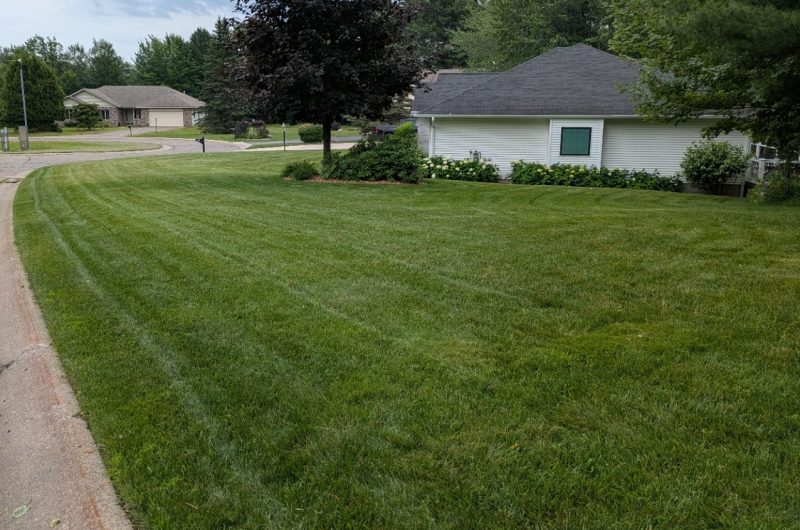Eviction in the U.P. Deserves a Closer Look

Mia Brodeur is a Research Assistant at the University of Michigan’s Center for Local, State, and Urban Policy (CLOSUP), where she works on the Center’s “Close Up on the U.P.” project. She completed her undergraduate degree at U-M’s College of Literature, Science, and the Arts (class of 2024) and was part of the U.P. Scholars Program, studying German, Linguistics, and Translation. She is from the Upper Peninsula and is interested in the attitudes and policies of U.P. communities.
“CLOSEUP on the UP” is a collaboration between CLOSUP, U-M’s UP Scholars Program, and Rural Insights.
As of March 2023, The Eviction Lab reports that Michigan’s eviction filing rate jumped from historic pandemic-era lows to become the 5th worst in the nation at 16.7%. This means that more than 16 evictions were filed by landlords for every 100 renter households across the state. Not all eviction filings lead to a forced move; in 2023 the Michigan Justice for All Commission reported that only 17% of filed eviction cases in Michigan resulted in a court-ordered physical eviction. Regardless, case filings alone burden tenants with associated costs and fees, and create records that may discourage landlords from renting to the affected tenants. Furthermore, with nearly half of Michigan renters (48.8%) paying over 30% of their income on rent, and an average wait time of over two years for the housing voucher assistance program, Michigan renters face significant barriers to affording their homes and avoiding eviction.

Statistics on housing in Michigan from The Eviction Lab.
Research on eviction in Michigan is becoming more widespread, such as this report from the University of Michigan on reducing eviction or the document on improving eviction proceedings published by the Michigan Supreme Court. However, in all 74 pages of the latter publication, information on how eviction functions in the Upper Peninsula remains rare and undiscussed. Although the report documents how evictions uniquely affect different races, population densities, and landlord types (e.g. individual or corporate), there is little discussion of how these factors differ between the Upper and Lower Peninsulas.
Although overall eviction rates in the Upper Peninsula are lower than the rates in the Lower Peninsula, U.P. renters should not be left out of the conversation. While it is appropriate to direct resources to tenants in the areas with the highest threat of eviction, leaving areas of the state like the U.P. understudied risks missing out on vulnerable populations that would benefit from targeted eviction prevention measures.
Eviction in Specific U.P. Counties
Using eviction filings data from 2018 gathered by the Princeton University-run Eviction Lab, I selected six U.P. counties with a range of filings rates: Delta, Iron, Dickinson, Gogebic, Houghton, and Chippewa. (Note: As of 2018, Marquette County had an eviction filing rate of 3.4%. I did not include it in this analysis, since that number did not fit into the high, moderate, or low rate categories. For an article focused on housing in Marquette, see Rethinking ‘Affordable’: The Case for ‘Attainable’ Housing in Marquette.)
Looking at Figure 1 below, we see that Iron and Delta County have the highest 2018 eviction filings rates in the U.P. at 6.5% and 6.4% respectively. Then comes Dickinson (4.1%) and Gogebic (4.0%) with moderate rates, along with the lower rates of Chippewa (2.3%) and Houghton (2.1%).
Figure 1: 2018 Eviction filing rate by county
Iron County’s 6.5% filing rate may appear low compared to Michigan’s overall 2018 eviction filing rate of 16.1%. Compared to the chart below, though, we see that the eviction filing rates in these U.P. counties are similar to the statewide eviction filing rates in other Great Lakes States. This comparison highlights that the frequency of eviction filings in U.P. counties is at the level to match or exceed eviction filing rates in nearby states.
Using data from the Spring 2023 edition of the University of Michigan’s ongoing Michigan Public Policy Survey (MPPS), I analyzed the responses of the selected districts’ government officials to questions about local housing. These survey data allow us to look into whether patterns exist between local government officials’ responses to questions about their knowledge of State of Michigan housing programs (Q17), or their judgements on local housing stock and recent housing issue discussions (Q15), compared to local eviction filing rates.
In the end, this inter-country analysis did not reveal neat patterns between individual U.P. county eviction filing rates and their local leaders’ judgments on housing issues. For example, when asked about their familiarity with Michigan’s Statewide Housing Plan — a document introduced by the state government in 2022, that lists eviction as a priority area — government officials from Chippewa County indicated similar levels of unfamiliarity with the program as officials from Iron County (42% completely unfamiliar), despite being on opposite ends of the filing rate spectrum. Varied responses are also found to questions about the existence of sufficient affordable housing and whether their local government has discussed housing issues in the last 12 months.
Unfortunately, these sorts of county-level comparisons with eviction filing rates is hampered by the lack of current data on eviction in the U.P. The most recent data for the region comes from 2018, yet filing rates have naturally fluctuated since then, particularly due to eviction-prevention measures instated in response to the COVID-19 pandemic. Additionally, outdated data coupled with a small respondent sample size from the MPPS survey do not allow for statistically significant results. Therefore, analyses like these are best used as tools to identify possible topics for more robust future research.
Eviction in the U.P.
To better understand the implications of eviction patterns across all U.P. counties, I analyzed all U.P. local government officials’ responses to the Spring 2023 MPPS. Using Q17 once again, these data show patterns between all U.P. local government officials’ responses to questions about their knowledge of State of Michigan housing programs, available to support both homeowners and renters, and local eviction filing rates.
As shown in Figure 2 below, there is a general lack of familiarity among U.P. local government leaders with some of the key housing programs offered by the State of Michigan. For example, nearly half (47%) say they are completely unfamiliar with the 2022 Michigan Statewide Housing Plan. These results suggest that one avenue of eviction prevention measures in the U.P. could focus on education about statewide housing programs and insuring their efficacy in smaller districts.
Figure 2: 2023 U.P. local government officials’ familiarity with State of Michigan housing programs

Source: Spring 2023 Michigan Public Policy Survey (MPPS) from U-M’s Center for Local, State, and Urban Policy
Future Research
This lack of conclusive results highlights some of the difficulties in conducting eviction research about the Upper Peninsula. Outdated statistics, the lack of a statewide data collection, and uncertainty among local leaders about renter assistance programs in their communities add up to complicate eviction research. For future analyses about eviction in the Upper Peninsula, an overhaul of Michigan’s eviction tracking data infrastructure is critical. The Michigan state government could join other states by collecting and distributing eviction data itself, rather than housing it within difficult-to-access county court systems. This change would allow researchers to utilize current, accurate data on evictions, and it would ensure that information on the Upper Peninsula is just as accessible as the Lower Peninsula.
The Upper Peninsula is a unique part of Michigan that deserves to be treated as such in future eviction research. We have been seeing a surge of interest in the problem of eviction in Michigan, producing instructive reports and informing Michigan eviction prevention programs. This shows that it is not enough to simply collect statistics about the eviction U.P., we need interested groups to follow in the footsteps of previous researchers and, using U.P. specific data, conduct analyses to uncover the best ways to support U.P. tenants. I hope this article will spark interest in the topic and encourage ongoing learning and discussion — the closer look the U.P. deserves.
Additional Sources
Eviction is a complex process with more nuances than this brief can cover. For those interested in learning more on the topic, please visit the sources below.
https://taubmancollege.umich.edu/project/michigan-eviction-project/
https://poverty.umich.edu/publications/michigans-eviction-crisis/
https://poverty.umich.edu/research-funding-opportunities/data-tools/michigan-evictions/








“Local leaders”
A very generic term that doesn’t identify whether or not local governments have the people who are dedicated to housing.
These local leaders who are uninformed as to state aid for their constituents: You need an education!
Very interesting read!
I wonder how the rates of home ownership vs.rental compare between the UP and the rest of the state, and among the counties studied, and whether and how that impacts eviction rates.
Really an interesting study Ms Brodeur,
Your statistics and numbers don’t happen by accident .
Your study and facts are just that! A real starting point in a very real problem here in UP Michigan.
My own take in sitting in on such meetings is they the people in these small bergs all across Michigans Upper Peninsula absolutely do not for the most part have any expertise in housing promotion for their local economies and are often looking to hire a city manager or like professional with such expertise to guide a small community/town/city .
So you should be commended in identifying what we all recognize here as a true problem throughout Michigans UP.
And not chastised as someone who needs education??
Really ??
Sounds like you hit a nerve here and instead of this individual building a dialogue about the problem WE ALL KNOW EXISTS.
Your facts are attacked and your credibility questioned by what I refer to as the old guard that inhabits the thinking of a very closed and controlling group of people that hide behind personal interests, and old families and attitudes all across the Michigan UP.
Which can be proved by another fact that the Upper Peninsula of Michigan has less population than 100 years previously recorded in something called books!
As for you Ms Brodeur Bravo!
[…] 2023, Michigan had an eviction rate of 16.7%, ranking the fifth-worst eviction rate in the country. In 2024, that rate rose to 21%. Since 2020, […]
Great article, thank you!
[…] same thing happens at the University of Michigan, being located in the state with the fifth-worst eviction rate in the country. In one of the friendliest college towns in the U.S., recognized for its “welcoming […]
[…] few evictions, though a recent look suggests even rural areas are not immune if poverty is presentruralinsights.org – for example, some UP counties had mini spikes as pandemic aid […]